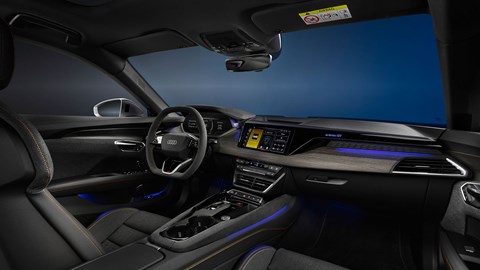► Audi has tweaked its flagship EV
► New suspension and more power
► Plus, more range and faster charging
Audi has given the e-tron GT a comprehensive update. The firm has fiddled with almost every part of the electric car, tweaking its chassis, motors, battery pack and charging system to keep it competitive with newer rivals such as the BMW i5 and Mercedes EQE.
Audi also seized the opportunity to launch a new RS performance version of the e-tron GT. It’s the most powerful car the company has ever built, with a colossal output of 912bhp and a stomach-churning 0–62mph time of 2.5 seconds.
The updated Audi e-tron GT will hit UK showrooms in August 2024. Audi hasn’t yet confirmed prices for the car but, considering how much has changed over the old car, we’re expecting a significant increase. Scroll down to learn everything we know so far.
What the biggest change?
Audi has addressed our biggest complaint. The e-tron GT has always been pitched as a continent-crossing super-tourer – but you couldn’t drive it much further than 200 miles without stopping to charge it.
But the new e-tron GT has a lighter, more energy-dense battery pack that promises to fix that. Its gross capacity has climbed from 93kWh to 105kWh, boosting maximum range to 375 miles. Despite this, the new battery is nine kilogrammes lighter than before.

Audi found this extra power by adjusting the chemistry of the battery’s cells and improving its cooling system. Plus, Audi has increased the power of the e-tron’s regenerative braking system, so less energy is wasted when decelerating.
And when you do eventually need to stop for some electricity, you won’t be waiting around as long. Now, the e-tron GT can charge at speed of up to 320kW. That means, if you can find a charger capable of supplying that much power, you’ll be able to drive for 174 miles after just 10 minutes of charging.
What about the motors?
There are now three versions of the car – the S e-tron GT, the RS e-tron GT and the RS e-tron GT performance – and performance has improved across the board. The S e-tron GT is the entry-point to the range, but it still has two electric motors delivering a healthy output of 671bhp. Audi says that’s enough for a 0–62mph time of 3.5 seconds.
The RS e-tron GT used to be the flagship of the range. It’s now the middle option, which gives you an idea of just how much harder Audi is pushing the car’s platform. It churns out 844bhp and can sprint from 0–62 mph in 2.8 seconds.

The new flagship model, the RS e-tron GT performance (above), has supercar-rivalling levels of performance. It has roughly the same amount of power as a McLaren P1 and can sprint from 0–62mph as quickly as a Ferrari SF90.
Audi has made some changes to the RS models’ powertrains to improve their drivability. Changes include stronger driveshafts and optimised mapping, which it says has smoothed out the power delivery. There’s also a new ‘boost’ function that gives the driver an extra 94bhp at the push of a button.

To help support all this extra power, Audi developped a new two-chamber active air suspension system for the e-tron GT. The tech is fitted as standard on Vorsprung versions of the car – and Audi says it has improved the car’s driving dynamics without compromising on comfort.
The firm’s engineers claim it can keep the GT’s body almost horizontal during hard cornering, braking and accelerating by jacking up the corner of the car on which the G-forces are acting. It also has a comfort entry feature which can raise the car’s ride height to 77mm when parked (which is 55mm higher than normal).
What’s changed inside?
Lots of little things. Audi has fitted it with a new flat-bottomed steering wheel, fresh wooden trims for the dashboard and centre console and new treadplates. The cheapest S e-tron GT variant also now comes as standard with 14-way electrically adjustable seats, while Vorsprung variants can be optionally equipped with a massage function.
Buyers get a few technology upgrades, too. Audi has reskinned the RS e-tron’s digital gauge cluster with a white power gauge, as a tribute to the white analogue dials fitted to the 1994 RS 2 Avant. Plus, you can specify a new polymer-dispersed liquid crystal panoramic sunroof as an optional extra. The tech means the glass panel can be switched from completely transparent to entirely opaque at the touch of a button.

Audi has one eye on the environment, too. The e-tron GT’s cabin uses loads of sustainable materials – namely a sustainable microfibre called Dinamica and a recycled fabric called Cascade. The car’s carpets and floor mats are also made from Econyl, which is made entirely from recycled nylon fibres from reclaimed production scraps and discarded fishing nets.